

This material describes methods to concentrate diffuse light. Although the presentation does not meet rigorous scientific standards the fundamental concepts appear to be sound. It is presented for review and consideration.
Concentration of diffuse light is desirable for several reasons. A concentrator could serve as a motionless solar tracker, thereby increasing the effectiveness of solar power. Concentrators coupled to optical fiber could function as one-way windows to allow light into rooms through small apertures. Underground greenhouses would be possible.
An infrared (IR) diffuse-light concentrator would create a spontaneous flow of heat from one side of the concentrator to the other. For example, an IR concentrator placed in the wall of a common picnic cooler would produce a static hot or cold condition inside the cooler. Clothing containing IR concentrators would heat or cool spontaneously.
This is possible because of blackbody radiation. At room temperature all matter radiates infrared light (heat) at an intensity on the order of 10 to 100 watts/m². If our eyes were sensitive to infrared light all objects would appear to be embers glowing like those at the base of a fire. We are bathed in infrared light. A diffuse-light concentrator would act as a check-valve through which light would flow in one direction with greater intensity than in the other direction.
Atoms produce blackbody radiation. To utilize blackbody radiation is to utilize power produced by individual atoms. Hypothetically, a diffuse-light concentrator could concentrate this power which could then be used to drive a heat engine. This appears to violate certain laws of thermodynamics, but there is a loophole. The concentrator would not create energy out of thin air, but it would gather IR energy passing through thin air. As heat increased at the concentrator it would decrease in the surrounding area resulting in no net change in the entire system. It would translate power from the atomic scale to power at a macro scale by combining the effects of the multitudes of individual atoms.
Perpetual motion on a scale between planetary and atomic is obstructed by the close proximity of matter which constantly collides and dissipates force vectors. Concentration of blackbody radiation is one way to coordinate the actions of individual atoms without dissipating through collisions the concentrated power.
Prototypes of three categories of diffuse-light concentrators have been constructed. The materials used were transparent to visible light and opaque to IR light. They functioned as expected. Detailed descriptions follow. The IR prototypes remain to be constructed.
This approach to the concentration of diffuse light utilizes refraction. In a transparent medium with boundaries possessing different refraction characteristics there will be a greater probability of transmission across one of the boundaries.
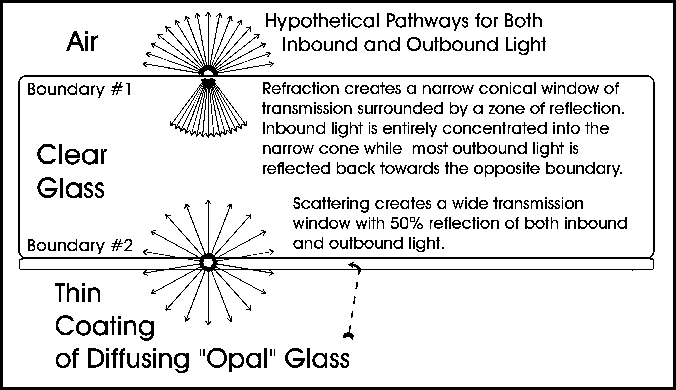
A sheet of glass with a diffusing "opal" coating on one side is an example of a boundary-pair with a refraction differential. The smooth boundary between glass and air exhibits the index of refraction of the glass, approximately 1.5. The opposite boundary between clear glass and diffusing opal glass exhibits an effective index of refraction of 1.0 because any light entering the clear glass from the diffusing glass is scattered equally in all directions.
Approximately 96% of inbound light which strikes the clear boundary enters the glass (with 4% reflected) whereas only 50% of inbound light which strikes the opal boundary enters the glass (assuming that the opal glass scatters light with equal probability in all directions). Outbound light from inside the glass has a 50% chance of exiting via the opal boundary whereas it has less than a 50% chance of exiting via the clear boundary because of total internal reflection.
Thus, the opal boundary reflects more external light and transmits more internal light than does the clear boundary. Consequently, a piece of diffusing glass appears brighter on the opal side than on the clear side because of the imbalance. More light flows from the clear side to the opal side.
When constructing the prototype it was necessary to abrade the surface of the opal coating because it had been polished smooth which had the effect of creating a second clear boundary. After the polished surface had been removed from the opal coating the imbalance was apparent to the unaided eye. The rough opal surface was obviously brighter than the smooth glass surface under similar lighting.
The difference is more pronounced when viewed from an angle because the effects of refraction are more significant at higher angles. Furthermore, it is apparent that an anti-reflective coating on the smooth glass surface would contribute to an even greater imbalance (unless anti-reflective coatings function equally in both directions, a detail which is elusive and remains to be researched).
It should be possible to create a measurable temperature differential using a thin sheet of material which is transparent to room-temperature infrared light. Several hundred square centimeters of the sheet, polished on one side and rough on the other, should be sufficient. Thermometers on each side of the sheet sandwiched between two insulating blankets should register a noticeable difference in temperature, although much will depend on the characteristics of the sheet. The effect will be cumulative if sheets are stacked.
A particularly intriguing possibility is a sheet of ordinary glass bonded to a sheet of ordinary table salt. If the technical problems could be surmounted (sodium chloride is extremely brittle and may not bond to glass) the resulting sandwich would have excellent characteristics. Visible light would pass directly through both layers, but IR light would only pass through the salt. IR light would be absorbed and re-emitted by the glass which would have the effect of scattering the IR light as did the opal layer in the previous example. The sandwich would function as a boundary-pair with a refraction differential across the salt. The sandwich would look like a normal window but the glass would radiate heat and the salt would absorb heat.
The next approach to the concentration of diffuse light is the differential lens which utilizes curvature to increase the effects of refraction. Given equal radiant intensities of ambient light and the surface of a target, a differential lens will create a spontaneous net flow of light (a flow differential) towards the target. The target typically has a smaller area than does the lens which increases the efficiency of a differential lens when compared to a flat refraction differential concentrator of equal area. Some designs utilize refraction differential, some don't.
The objective of a differential lens is to converge parallel light from the most possible directions onto the smallest possible target. The optimum shape for a lens to concentrate light from many directions is circular and the optimum position for the target in a simple differential lens is at the radial center of the lens. A target placed in the center of a circular lens receives concentrated light from all directions. If the target is moved away from center it rapidly loses a significant portion of magnified directions which will only be beneficial if the conical window of incoming radiation is narrow. These designs can be implemented in two or three dimensions (cylindrical or spherical).
The optimum size of the target is that size which causes the target to appear to just fill the lens. This depends on the refraction of the lens medium. For common glass, the magnification at the center of a circular lens is approximately two to one. Thus, the target size for glass would be 1/2 the diameter of the lens. A target may be opaque or transparent.
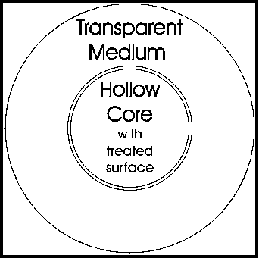
A hollow cylinder with an internal diameter half that of the outside diameter is a simple example of a differential lens. Transparent material such as sodium chloride with an index of refraction of 1.5 will magnify the hollow center target of the cylinder. The target will appear to have approximately the same diameter as the lens. The surface of the target must be treated to allow the incoming light to cross the boundary between the medium and the air (in other words, to prevent total internal reflection). For example it could be made rough or it could be coated with an opaque material of sufficient density to absorb light even at oblique angles.
In this example the target will receive incoming IR radiation with greater intensity than ambient because of the magnification. However, it will radiate IR light at the normal rate for its temperature. An IR-sensitive camera viewing the target through the lens would perceive the target to be cooler than it actually is (specifically, the center will appear true and the apparent temperature will decrease toward the edges). Consequently, because of the increased rate of absorption the target will increase in temperature until the rate of emission has increased to compensate for the rate of absorption. At this point a static condition will exist in which the core is warmer than the surroundings.
A visible-light prototype for this method was constructed with a 6" diameter sphere containing a darkened temperature sensor placed at the center of the sphere. Because of the magnification, the sensor appeared to be approximately twice its size in all three dimensions. This implies a surface area four times greater than true. As a result, the sensor was highly sensitive to visible light. Even dim light in the room would immediately cause the temperature to climb. Only in complete darkness did the core temperature stabilize at room temperature.
The sphere creates some interesting optical illusions. For example, the tiny sensor had been placed in a short pipe for added surface area and because of the distortion caused by the spherical lens it is possible to look into both ends of the pipe simultaneously from any direction normal to the axis of the pipe. The ends appear to bend and follow the viewer around the room.
The sensitivity of the sensor to visible light was amplified by the greenhouse effect of the material of the sphere. Visible light passed through to the sensor but IR light could not radiate out because the sphere is opaque to IR radiation. Because this test was affected by the greenhouse effect of the sphere, another prototype must be constructed of IR-transparent material. Appropriate material will cause the core to remain warm, even in complete darkness.

A hemispheric IR lens with a flat target or with a hollow hemispheric target would absorb light from the curved side and radiate it towards the flat side. This has greater efficiency than does a flat boundary-pair design. This design could be miniaturized, mass produced and incorporated into cloth which would then actively contribute to heating or cooling. Some IR materials have higher refraction indices than does sodium chloride (such as 4.0 for germanium) which would allow for smaller targets and greater efficiency. Again, the target must be treated to prevent total internal reflection.
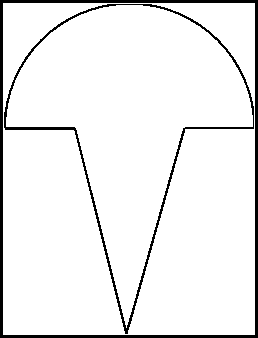
This "thumbtack" design is a variation on the previous hemispheric lenses. The target in this case is transparent which facilitates applications for visible light. Multiple miniature lenses arranged in a honeycomb pattern with the pointed conical targets projecting through holes cut in an opaque sheet would create a differential window. More light would enter the hemisphere than the cone.
This approach to the concentration of diffuse light does not require a refraction differential. It applies standard principals utilized in conventional lens design.
The ultimate differential lens would be a theoretically perfect "universal" lens which would concentrate all light from all directions onto a single point. Because of inherent limitations the following design of an imperfect universal lens cannot approach the efficiency of a perfect lens. Nonetheless it is more efficient than the previous methods and has the advantage of de-scattering the light, thus allowing the use of more familiar and mature lens technology. The target is not positioned in the center of the circular lens.
This particular design of a universal lens consists of multiple stages of multiple lenses. In other designs some components may be integrated to simplify the design but the fundamental steps remain the same. The three essential steps are 1) convergence of parallel light by a primary stage with high rotational symmetry, 2) normalization of the output of the primary along its focal arc and 3) redirection of the resulting concentrated light.
A non-integrated design for a universal lens:
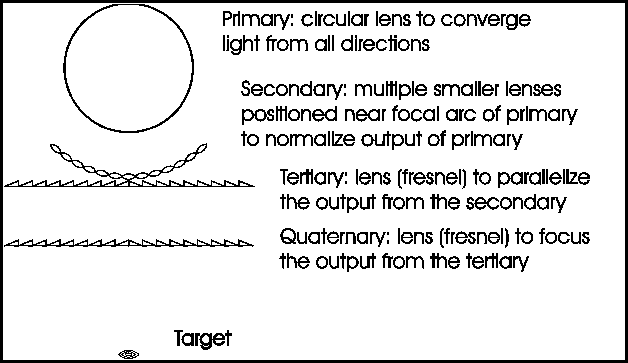
This design presents simple challenges such as the spherical aberration that is typical of circular lenses or the narrow 90º conical absorption window caused by the partial arc of the secondary. Even still, it is a simple matter to construct a lens that exceeds the efficiency of the simpler radial-center designs.
A crude prototype universal lens has been constructed with a 101.6 mm diameter acrylic sphere primary (73.3 mm focal length), 1 mm diameter secondaries (0.6 mm fl) and a 50.8 mm diameter fresnel tertiary/quaternary (33 mm fl). As expected, the spherical aberration is apparent. Nonetheless, a narrow test beam of laser light passing once through an arc of 40º is redirected by the lens such that it passes over the target in a rapid sweeping manner 50 times. The sweeping path could easily be shortened and the frequency increased by trimming the secondaries to fit more closely which would make the output more stationary and thus improve efficiency.
Experienced lens manufacturers could easily compensate for many of the simple challenges presented by this design. A properly constructed universal lens will illuminate the target with more intensity than ambient light. It should be easily detectable to the unaided eye. This type of lens is well-suited for coupling to fiber optics for use as one-way windows.
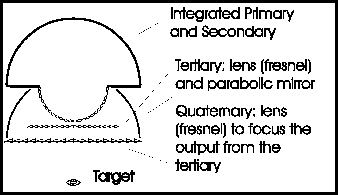
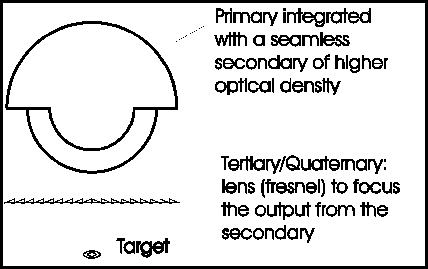
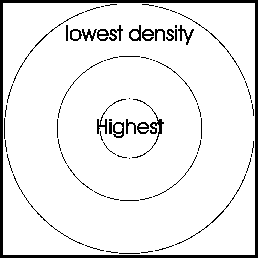
At this point in time the most significant development yet to be achieved is the construction of an IR prototype to test the hypothesis of spontaneous heat flow. This development will be the focus of effort until such time that the premise has been either proven or disproved. Current efforts involve attempts to grow large sodium chloride monocrystals in a kiln. These efforts have met with limited but promising success. The objective is a hollow cylindrical crystal of sodium chloride 5 to 10 cm in diameter by 20 to 30 cm in length. This may be of sufficient size to produce measurable spontaneous warming of the core. Any independent effort by others to prove or disprove the hypothesis by other means would be sincerely welcomed.
If the process of diffuse-light concentration proves to be practical, some benefits may be available within two or three years. There will probably be four categories of products: heating/cooling components for climate control panels and clothing, one-way windows with fiber optics for illumination, heat engines for electrical power generation, and heat engines for transportation. Climate control and illumination may require less research and development than will heat engines. This would allow for the earliest introduction into the market of panels, clothing and windows. Because of the low power density of blackbody radiation all products will require large surface areas which, with respect to design time, favors climate control, illumination, and stationary power plants over transportable heat engines. Heat engines in automobiles, if practical, may not be ubiquitous for as many as 15 or 20 years because of R & D necessities.
Finally, should the process of diffuse-light concentration prove to be practical it is likely that there will be subsequent discoveries which further demonstrate the need to refine the current models of thermodynamics and physics. This may be the tip of the iceberg.
The author is 42 years old and lives in a cold climate (which explains his interest in heat). He is a college dropout with a high school diploma. He has worked as a computer programmer for a government facility and as a technician for various oilfield service companies. For the past 8 years he has lived alone in a small shack in the forest with a little help from some old solar panels. He constructs lens prototypes in a tool shed using clock domes, lamp globes, casting resin, acrylic rods, and various odds and ends. His kiln is sheltered in a disabled van. His name is Ted Neville and he can be reached at Author of this article. Be advised that he rarely returns correspondence. Don't take it personally. 4-May-1999
